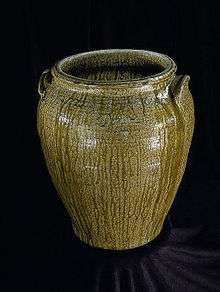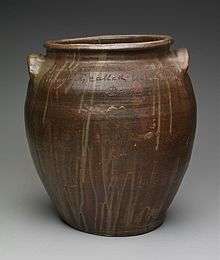David Drake (potter)
David Drake (c. 1800 – c. 1870s), also known as "Dave Pottery" and "Dave the Potter," was an American potter who lived in Edgefield, South Carolina.


Drake produced over 100,000 alkaline-glazed stoneware jugs between the 1820s and the 1870s. An enslaved African American, he often signed his works "Dave." He is recognized as the first enslaved potter to inscribe his work, during a time when most enslaved people were illiterate, often forbidden from literacy, and anonymous.[1] Drake inscribed his work with poetry, often using rhyming couplets,[2] as well as his signature.[3][4][5]
Life
David Drake is thought to have been born the first half of the year 1800 on a plantation in South Carolina, owned by the Drake family.[3] The first legal record of Drake is a description from June 13, 1818, that describes "a boy about 17 years old country born" who was "mortgaged to Eldrid Simkins by Harvey Drake".[6] "Country born" refers to an enslaved African American who was born in the United States rather than Africa.[3] During the antebellum period, Drake was one of the 76 known enslaved African American to have worked in Edgefield's twelve pottery factories.[7]
David Drake was first enslaved by Harvey Drake. Harvey Drake owned a large pottery business with his business partner Abner Landrum. This pottery business and the area, within which David Drake worked is known as Pottersville. Landrum was the publisher of a local newspaper called The Edgefield Hive.[3] It is unclear how Drake learned to read and write. Scholars speculate he was taught by Landrum, who was known to be a religious man and may have taught Drake how to read the Bible.[3] During this time period it was unusual for enslaved people to be literate, especially in South Carolina. Most southern states in the early 1800s restricted black literacy, and in 1830s legislation was passed laws prohibiting their education.[8] South Carolina's Negro Act of 1740, prohibited teaching enslaved Africans to read and write, punishable by a fine of 100 pounds and six months in prison
After the death of Harvey Drake, David Drake was enslaved by Rev. John Landrum. In 1846 Rev. Landrum passed away and all eighteen of the people he enslaved were put up for sale. Drake was then purchased and enslaved by Rev. Landrum's son, Franklin Landrum. Drake's treatment under Franklin Landrum was poor.[8] During the period of his enslavement by Franklin Lundrum, Drake's wares were not inscribed and no poetry is thought to have been produced.[3]
In 1849, Lewis Miles bought and enslaved Drake. During the time Drake produced his largest amount of wares that included poetry.[8] Miles' factory was known as 'Stony Bluff.' Drake's poetry at this time increased from one every few years to three in 1857, eight in 1858, and seven in 1859.[3]
At the end of the Civil War, Drake was a free man and it is thought he took the surname "Drake" from his first owner Harvey Drake. The name "David Drake" is recorded in the 1870 United States Census as "David Drake, turner."[7] It is thought that Drake died in the 1870s, as the names "David Drake" nor "Dave Drake" do not appear in the 1880 census.[3]
Pottery and work
Drake's earliest recorded work is a pot dated July 12, 1834.[9] The poetry on this vessel reads:[9]
Putevery bit all between
surely this jar will hold 14
Drake scholar, Jill Beute Koverman argues that Drake "made more than 40,000 pieces over his lifetime."[10] A total twenty of Drake's jars and jugs are inscribed with original poetry and fifty additional vessels reveal his signature, maker's mark, date, and other inscriptions.[9] Drake's jars are bulbous in form, similar to most ware produced in antebellum Edgefield. Drake is known for the massive size of his ware and the largest jar attributed to Drake holds 40 US gallons (150 l) and measures 29 inches (74 cm) tall, with a circumference of 85 inches (220 cm).[11] One marker of Drake's work is that his jars are widest at the top - "They are wide-mouthed forms with thick, rolled rims and high broad shoulders. Contemporary potters who have examined Drake's thick-walled, large capacity storage jars are amazed at the great strength and skill that was required to produce vessels of such size."[9] The use of Drake's ware ranged from pitchers for buttermilk, jugs for molasses or whiskey, churns for butter, large jars for pickling vegetables or preserving meats such as venison and bear.[11]
Drake commonly used 25–40-US-gallon (95–150 l) jugs, which he frequently adorned with short poems and couplets below the rim of the jar.[9] Some of these were explanatory "Put every bit all between / surely this jar will hold 14;" and some were commentaries on the selling of slaves "I wonder where is all my relations / Friendship to all—and every nation." This unusual feature of his work is one of his most famous trademarks. Some collectors and scholars have suggested that Drake's poetry should be characterized as an early act of sedition in the cause of civil rights, because at the time it was generally forbidden for African-Americans to read and write.[12] Pieces by Drake frequently feature the initials "LM." This stood for Lewis Miles, the man who owned the pottery workshop where Drake worked (Miles may have enslaved Dave for a time, starting in the late 1830s).[12] Lewis Miles has even been referenced directly in one of Drake's couplets: "Dave belongs to Mr. Miles / Wher the oven bakes & the pot biles."
Legacy
In 2010, the children's book Dave the Potter: Artist, Poet, Slave was written by Laban Carrick Hill and illustrated by Bryan Collier. The book gives a biography of Drake as well as his prowess for creating pottery. It won the Coretta Scott King Award and was a Caldecott Honor book in 2011.
During Drake's lifetime his pots were worth around 50 cents; However today, they sell for as much as $50,000.[11] In contemporary auctions and sales, his work has sold for over $40,000 per piece.[13]
In 2008 Leonard Todd published a cohesive biography on Drake. Leonard Todd's interest lies in the fact that two of his ancestors enslaved Drake at some point in time.
The 1998 exhibition The Life and Works of the Enslaved African American Potter, Dave at University of South Carolina's McKissick Museum was the first exhibition devoted solely to Drake's pottery.[11] In 2010 contemporary artist Theaster Gates created an exhibition responding to and centering around the work of David Drake, titled Theaster Gates: To Speculate Darkly at the Milwaukee Art Museum. In this exhibitions Gates uses Drake's work to address issues of craft and race in the African American history.[14]
In 2016 an exhibition at the Vero Museum of Art titled David Drake: Potter and Poet contained 31 objects; 13 of which are known to be from Drake's hand.
Collections
Drake's work is in various collections, most notably the Southern Collection of the Greenville County Museum of Art (Greenville, SC), the Smithsonian collection of the National Museum of American History in Washington DC.[15] Philadelphia Museum of Art,[16] Museum of Fine Arts, Boston,[17] and the McKissick Museum at the University of South Carolina.[18]
See also
- List of slaves
References
- de Groft, Aaron (1998-01-01). "Eloquent Vessels/Poetics of Power: The Heroic Stoneware of "Dave the Potter"". Winterthur Portfolio. 33 (4): 249–260. doi:10.1086/496754. JSTOR 1215184.
- Wood, Marcus (2010). The Horrible Gift of Freedom: Atlantic Slavery and the Representation of Emancipation. University of Georgia Press. ISBN 9780820334271.
- Todd, Leonard. "Dave's Life". Carolina Clay: The Life and Legend of the Slave Potter, Dave. Retrieved 14 March 2015.
- "Dave the Slave Potter". Our Infamous History. Edgefield, South Carolina. Retrieved 14 March 2015.
- "Dave the Potter – Pottersville, Edgefield County, South Carolina" (Includes Photos)". South Carolina Information Highway. Retrieved 14 March 2015.
- "Dave, the Potter (aka David Drake)". Encyclopedia of African American Writing. Credo Reference. Retrieved 7 February 2017.
- Beute Koverman, Jill (February 2017). "The Ceramic Works of David Drake, aka, Dave the Po er or Dave the Slave of Edge eld, South Carolina". American Ceramic Circle Journal. 13, 2005: 83–98 – via McKissick Museum Commons.
- Leonard., Todd (2009). Carolina clay : the life and legend of the slave potter Dave. W.W. Norton. ISBN 978-0393058567. OCLC 300404359.
- Baldwin, Cinda (April 2014). Great and Noble Jar: Traditional Stoneware of South Carolina. University Of Georgia Press. p. 41. ISBN 978-0820346168.
- Reif, Rita (2000-01-30). "Art/Architecture; In a Slave's Pottery, a Saga of Courage and Beauty". The New York Times. ISSN 0362-4331. Retrieved 2017-05-21.
- "A Slave, a Poet, a Potter: Preserving the Legacy of David Drake". The Chronicle of Higher Education. 1998-07-31. Retrieved 2017-05-21.
- Wingard, Pete. "WHAT'S HOT in Collecting Southern Stoneware". McElreath Printing & Publishing. Retrieved 14 March 2015.
- "Dave the Potter" Archived 2007-02-16 at the Wayback Machine, University of South Carolina
- "Theaster Gates Speculates Darkly : Chicago Art Magazine". chicagoartmagazine.com. Retrieved 2017-05-21.
- "Jar made by "Dave"".
- "Storage Jar". Philadelphia Museum of Art.
- "Storage Jar". MFA Boston.
- "History of Collections". McKissick Museum - University of South Carolina.
External links
- Todd, Leonard. "Carolina Clay: The Life and Legend of the Slave Potter, Dave". Retrieved 14 March 2015.